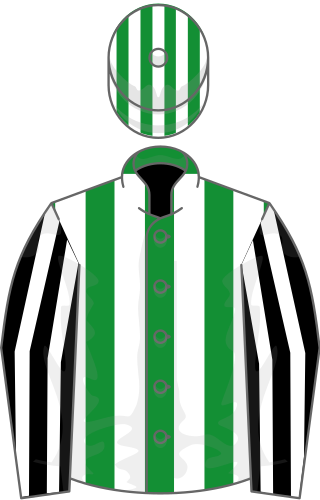
The Grand National is a National Hunt horse race held annually at Aintree Racecourse, Aintree, Merseyside, England. First run in 1839, it is a handicap steeplechase over an official distance of about 4 miles and 2½ furlongs, with horses jumping 30 fences over two laps. It is the most valuable jump race in Europe, with a prize fund of £1 million in 2017. An event that is prominent in British culture, the race is popular amongst many people who do not normally watch or bet on horse racing at other times of the year.
In horse racing in Great Britain, France and Republic of Ireland, National Hunt racing requires horses to jump fences and ditches. National Hunt racing in the UK is informally known as "jumps" and is divided into two major distinct branches: hurdles and steeplechases. Alongside these there are "bumpers", which are National Hunt flat races. In a hurdles race, the horses jump over obstacles called hurdles; in a steeplechase the horses jump over a variety of obstacles that can include plain fences, water jump or an open ditch. In the UK, the biggest National Hunt events of the year are generally considered to be the Grand National and the Cheltenham Gold Cup.

Aintree Racecourse is a racecourse in Aintree, Metropolitan Borough of Sefton, Merseyside, England, bordering the city of Liverpool. The racecourse is the venue for the Grand National steeplechase, which takes place annually in April over three days. Aintree also holds meetings in May and June, October (Sunday), November and December.
The Chair is a fence on Aintree Racecourse's National Course and thus is one of 30 that are jumped during the Grand National steeplechase which is held annually at the racecourse near Liverpool, England.

Red Rum was an Irish champion Thoroughbred steeplechaser. He achieved an unmatched historic treble when he won the Grand National in 1973, 1974 and 1977, and also came second in the two intervening years, 1975 and 1976. The Grand National is a notoriously difficult race that has been described as "the ultimate test of a horse’s courage". He was also renowned for his jumping ability, having not fallen in 100 races.
The Coral Welsh Grand National is a Premier Handicap National Hunt steeplechase in Great Britain which is open to horses aged four years or older. It is run at Chepstow, Wales, over a distance of about 3 miles and 6½ furlongs, and during its running there are twenty-three fences to be jumped. It is a handicap race, and it is scheduled to take place each year on 27 December.
Anthony Bingham Mildmay, 2nd Baron Mildmay of Flete was an English amateur steeplechaser, who raced in the Grand National. He also inspired the Queen Mother's interest in National Hunt racing.

The 1997 Grand National was the 150th official running of the Grand National steeplechase held at Aintree near Liverpool. The race was scheduled to be run on Saturday 5 April 1997, but was postponed by two days to Monday 7 April after a Provisional Irish Republican Army (IRA) bomb threat forced the evacuation of the course.
Ernest Piggott (1878–1967) was a leading British jump racing jockey, whose family has become one of the leading dynasties in British horseracing. He was three times Champion Jockey and three times Grand National winner. His son, (Ernest) Keith Piggott (1904–1993), was also a leading jump jockey and National-winning trainer, while his grandson was the 11-times British flat racing Champion Jockey, Lester Piggott.
The 1910 Grand National was the 72nd official annual running of the Grand National horse race that took place at Aintree Racecourse near Liverpool, England, on 18 March 1910.
The 1980 Grand National was the 134th renewal of the Grand National horse race that took place at Aintree Racecourse near Liverpool, England, on 29 March 1980. The race, which carried the title, the World's greatest steeplechase, was won by Ben Nevis, ridden by the American amateur rider Charlie Fenwick. Only 4 horses finished the race out of 30 starters.
The 1932 Grand National was the 91st renewal of the Grand National horse race that took place at Aintree Racecourse near Liverpool, England, on 18 March 1932.
The 1929 Grand National was the 88th renewal of the world-famous Grand National horse race that took place at Aintree Racecourse near Liverpool, England, on 22 March 1929.
The 1919 Grand National was the 78th renewal of the Grand National horse race that took place at Aintree Racecourse near Liverpool, England, on 28 March 1919.
The 1887 Grand National was the 49th renewal of the renewal of the Grand National horse race that took place at Aintree Racecourse near Liverpool, England, on 25 March 1887.
The 1916 Grand National was cancelled because Aintree Racecourse was taken over by the War Office. However, a substitute race known as the Racecourse Association Steeple Chase was held at Gatwick Racecourse. The Gatwick races from 1916 to 1918 are not typically included in the true Grand National record books.
The 1917 Grand National was cancelled because Aintree Racecourse was taken over by the War Office. However, a substitute race known as the War Steeplechase was held at Gatwick Racecourse. The Gatwick races from 1916 to 1918 are typically omitted from the true Grand National records.

Gatwick Racecourse was a racecourse in the county of Surrey, England near to Horley and Lowfield Heath. It was in use from 1891 to 1940 when it was closed at the start of the Second World War. The land is now part of London Gatwick Airport.




